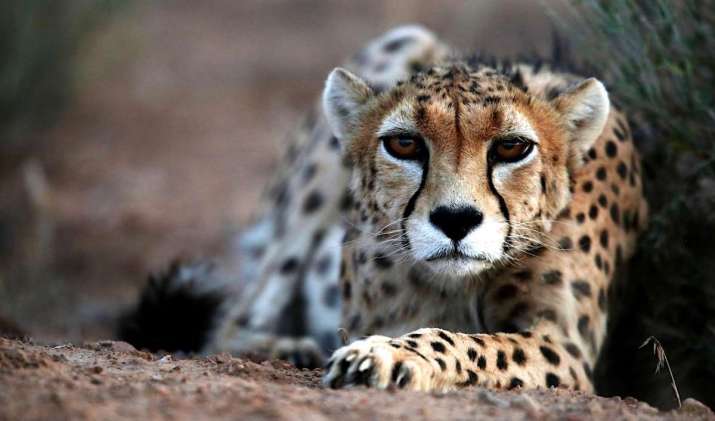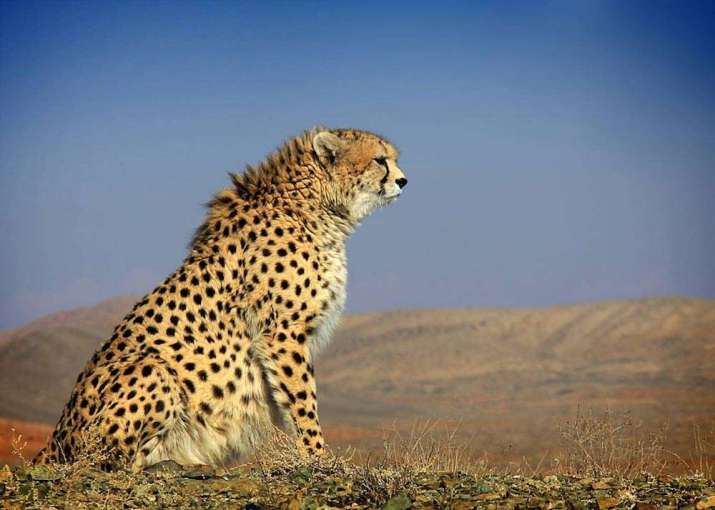NEWS
Fewer than 50 Asiatic Cheetahs Left in the Wild, Conservationists Warn
 A seven-year-old male Asiatic cheetah. Photo by Vahid Salemi. From theguardian.com
A seven-year-old male Asiatic cheetah. Photo by Vahid Salemi. From theguardian.comIn the wake of a UN decision to halt funding for conservation work to save the Asiatic Cheetah, scientists have warned that the critically endangered cat is on the brink of extinction, with fewer than 50 individuals believed to remain in the wild.
The Asiatic cheetah is the second-rarest cat in the world at the subspecies level, after the Amur leopard. The world’s last known population of wild Asiatic cheetah’s is found only in Iran, and conservationists say there is little chance of saving them without immediate intervention. The Red List of Threatened Species of the International Union for Conservation of Nature (IUCN) classes the Asiatic cheetah as critically endangered.
“Lack of funding means extinction for the Asiatic cheetah, I’m afraid,” said Iranian conservationist Jamshid Parchizadeh. “Iran has already suffered from the loss of the Asiatic lion and the Caspian tiger. Now we are about to see the Asiatic cheetah go extinct as well.” (The Guardian)
The United Nations Development Program (UNDP) announced last month that it is pulling out of the Conservation of the Asiatic Cheetah Project in Iran at the end of this year. The project will now be managed mainly by Iran’s Department of the Environment, the head of which has declared the Asiatic cheetah “doomed to extinction,” citing its declining population since 2001. (Nature)
“The Conservation of the Asiatic Cheetah Project was established in 2001 to save it from extinction. As a result of the project, we now have a better understanding of how many Asiatic cheetah are left and have increased the number of protected areas where they live. We have got the communities involved in the project,” said a UNDP spokesman, adding that the agency had committed some US$800,000 to the project in recent years. “The second phase of the project, which commenced in 2009, is scheduled to end December 2017. Unfortunately, due to budget challenges, UNDP is unable to extend the project beyond this time.” (The Guardian)
International economic sanctions against Iran exacerbate the precariousness of the situation, as the UN was one of the few organizations that could easily bring funding into the country. “Iran has faced heavy international economic sanctions since 1980, and international agencies have been encountering a lot of problems transferring money into the country for many years,” said conservation biologist Sam Williams of the University of Venda in South Africa. “The crucial point is that that money could have been used for the implementation of conservation strategies.” (The Guardian)
The famously swift and agile cheetah, capable of accelerating to up to 96km per hour in just three seconds, relies on speed to hunt down prey. Smaller and lighter in color than its African cousin, from which it separated between 32,000 and 67,000 years ago, the Asiatic cheetah could once be found in habitats across Afghanistan, the Arabian Peninsula, the Caucasus, Central Asia, India, and Pakistan, thriving in plains, semi-desert areas, and other open habitats with available prey.
In India, cheetahs were eradicated by sport hunters and the expansion of agriculture in the late 19th and early 20th centuries—three of India’s last cheetahs were shot by the Maharajah of Surguja in 1948. Cars, poachers, and local herders are the biggest threats facing the dwindling population in Iran, according to conservationists. At least 20 cheetahs have been killed attempting to cross highways over the past 16 years, and even farmers are willing to kill the cats to protect their livestock.
“Today, the cheetahs leave their [protected] zones and approach villages. Farmers and their dogs kill them to protect their herds," said Hooman Jokar, who heads Iran’s National Protection Project for the Asiatic Cheetah. (Phys.Org)
 Asiatic cheetahs once inhabited much of the Middle East and into eastern India. Photo by Morteza Eslami. From eathtouchnews.com
Asiatic cheetahs once inhabited much of the Middle East and into eastern India. Photo by Morteza Eslami. From eathtouchnews.comIran’s national initiative has worked hard to raise public awareness of the cheetah’s plight, even going so far as to have the cat’s image incorporated into the national football team's uniform for the FIFA World Cup and the Asian Games in 2014. “That move had an extraordinary effect in educating and mobilizing people,” said Jokar. “Now nearly everyone knows the cheetah is in danger.” (Phys.Org)
A new campaign that kicked off in September, headed by Iranian actress Hedieh Tehrani, raised some 8 billion rials [US$200,000] in just over a month to fund the relocation of farms away from cheetah habitats. “It’s the biggest mobilization of civil society that I’ve witnessed,” said Jokar. (Phys.Org)
There are also hopes for a pair of cheetahs living in one of Tehran's biggest national parks. Although the first pregnancy failed, park wardens say it bodes well as an indicator that the cheetahs are interested in mating.
See more
Asiatic cheetahs on the brink of extinction with only 50 left alive (The Guardian)
It’s still possible to save the Asiatic cheetah, the world’s second-rarest cat (The Conversation)
Save Iran’s cheetah from extinction (Nature)
UNDP not to extend Iran’s Conservation of Asiatic Cheetah Project (Tehran Times)
Iran moves to save last 'mascot' Asiatic cheetahs (Phys.Org)
Acinonyx jubatus ssp. venaticus (The IUCN Red List of Threatened Species)
Related news from Buddhistdoor Global
Asian White-backed Vulture on the Brink of Extinction, WWF Warns
Bhutan, WWF Launch US$43m Conservation Program for Protected Ecosystems
Rare Wild Tiger Caught On Camera in Bhutan
Buddhist Monk Highlights Need for Conservation on the Tibetan Plateau
Scientists Urge Endangered Status as Cheetah's Race to Escape Extinction
Buddhistdoor Special Issue 2017














